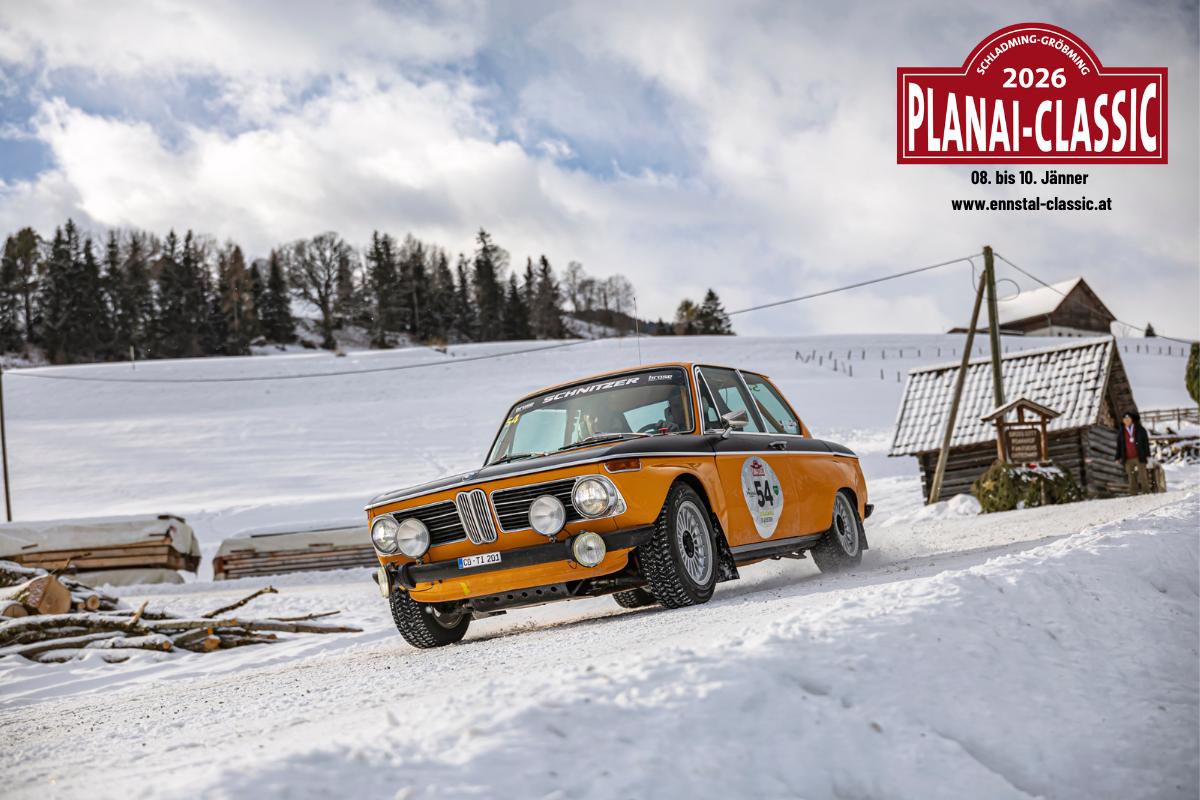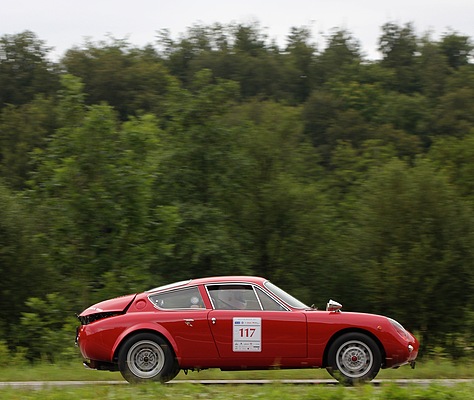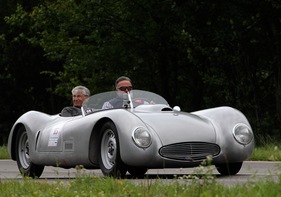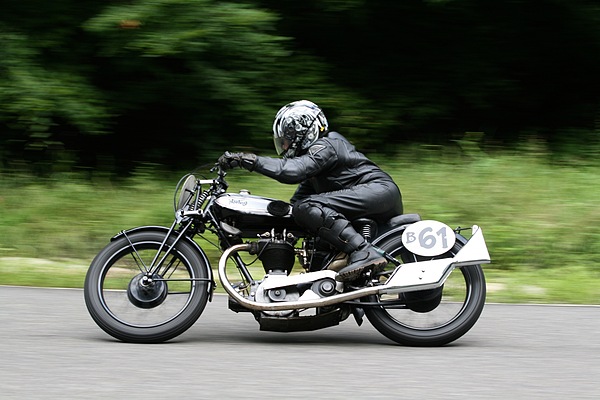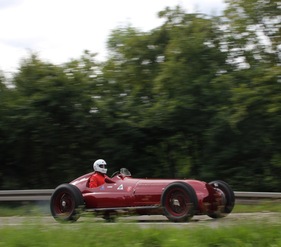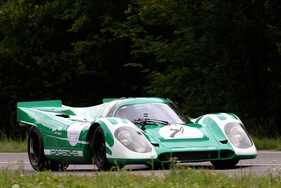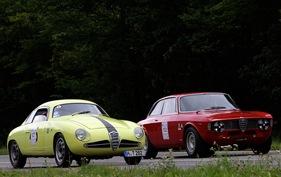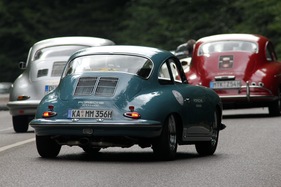It is quiet, only in the distance can you hear a track announcer over the loudspeakers. Then, suddenly, engines start up and roar. There are more, the noise swells, it is clearly audible from a distance. Then the noise level swells further, it is now a roar, tires squeal. You can hear engines revving up, then gear changes, engines revving up again. They have started. Then, after a few seconds, the noise dies down. It is almost silent again, only the track announcer can still be heard. Endless minutes later, the noise swells again, the racing cars approach, lined up like a string of pearls, they come around the corner, racing towards the finish again. One lap has been completed.
It must have felt and sounded exactly the same back then when twenty or more formula cars raced around the Solitude circuit. And that's exactly how it must have sounded last weekend, at the 2011 Solitude Revival. If it hadn't been for today's obligatory onboard cameras, full-face helmets, Nomex suits/gloves and a restrictive speed regime, you would have felt like you'd been transported back 50 years.
Revival of racing tradition
The last race at Solitude took place in 1965; in 2011, the full circuit from back then was used again for the first time. As back then, country roads, which were used during the week to get to work or to go out, formed a circuit a good 11 km long. And again, the formula cars, sports cars and GT cars raced in an anti-clockwise direction, while most of the circuits were clockwise.
The Solutide circuit
Solitude was incredibly fast in the 1960s; in 1963, Jim Clark lapped the 11.4 km circuit in a Lotus Formula 1 in 3:49.1 minutes, which corresponded to an average speed of 179.403 km/h. Even then, the track was largely a normal-width country road, mostly bordered by trees on the left and right, with crash barriers only in a few places. The track still looks like this today, except that there are speed limits of 60 and 80 km/h everywhere, which the racers had to observe, at least that was the motto.
Top-class field of vehicles
The organizers organized a rich field of vehicles, including many cars that had already taken part in the solo races up to 1965 or at least corresponded to a participating vehicle. Fans and experts clicked their tongues enthusiastically, held their thumbs up or even burst into storms of enthusiasm when old Bugatti or Mercedes-Benz SSKs from the pre-war era roared past. But the various Porsche 550 Spyders, two 904 GTSs, an Alfa Romeo Giulietta SZ, an Auto Union 1000, a Lotus 23, a Ferrari 250 GTO, several Mercedes Benz 300 SLs and the pack of Abarths also brought back the old days. And the fact that there was even a small field of FMR TG 500s, the fastest form of cabin scooter at the time, which caused a sensation in a special run in 1959, is to the organizers' credit.
The starting fields were supplemented by newer racing cars and sports cars, as well as vehicles from eras in which only motorcycle races or no races of the corresponding vehicle types took place at Solitude. These vehicles were certainly an asset for the public, as they included real gems such as David Piper 's original Porsche 917K from 1970, various Maserati monoposti, a pack of Abarth sports cars, Lancia rally cars and two Porsche 956s, to name just a few examples.
The formula racing cars of the early sixties
Solitude celebrated its high points in the early 1960s, when Formula 1 races were held that were not part of the world championship, but in which hardly any teams or drivers were absent. Over 300,000 spectators flocked to the race track in the park of Solitude Palace. The fact that there were only around 19,000 at the revival despite the cool and sometimes damp weather is considered a success. There wouldn't have been room for many more, as the large grandstands that lined the start-finish area in the 1960s, for example, are completely absent today.
But the cars from back then were back. The Formula 1 field included a Porsche 718 Formula 1 car from 1961, a Ferrari 156 V6 (also known as the Sharknose Ferrari because of its characteristic front), various Cooper, Brabham and Lotus cars. It is rare to see such a high-caliber starting field in this country. And the Formula Junior field also included vehicles such as the Stanguellini-Fiat, which were already competing at the end of the 1950s.
The Marcos Fastback GT from 1963
In 1965, a certain Terry W. Sanger took part in the SolitudeVIII racefor sports cars and prototypes up to 2000 cm3 in a Marcos Fastback GT , or at least he was registered. The vehicle was an exotic even then.
The chassis was more or less made of plywood and the coupé still had the provisions for the intended convertible in the form of a trunk opening and tarpaulin mounting buttons.
Exactly this vehicle, still weighing less than 500 kg, was also present at the Solitude Revival, largely untouched with the original wooden chassis. Almost a miracle!
The NSU Prinz II 30 from 1958
On July 19 , 1959, former team champion Hermann Böhm competed in Race II for production touring cars up to 600 cm3 with an NSU Prinz II 30 and finished in fourth place. It took him 59 minutes and 5 seconds to complete the 9 laps, with only 2 seconds separating him from third place. The NSU Prinz 30 dominated this race, followed only in 14th place by the first non-NSU, a Lloyd Alexander TS.
The Böhm car found its way to the Solitude Revival again in 2011 and delighted the audience with its unmistakable two-cylinder sound. After all, the Prinz 30's engine produced 30 hp, which meant a top speed of around 120 km/h . This meant it could easily overtake the VW Beetle.
Motorcycles and sidecars
The history of Solitude began with a short "hill climb" from Stuttgart West Station to Solitude Palace in 1903. And for many years, only motorcycles and sidecars competed. Accordingly, 60 racing motorcycles and sidecars delighted the audience, ranging from old Nortons to almost modern Hondas and Ducatis. BMW, NSU and Norton sidecars were also on display.
Supporting programs Bosch Boxberg Klassik and anniversary corso
In addition to the racing and sports car fields, the spectators were also kept entertained witha wide range of classic car drives by the Bosch Boxberg Classic Rally and a "125 Years of the Automobile" anniversary parade. There were many a jewel to discover here, from the Ford T-Model or a Buick from the beginning of the twentieth century to more recent models such as the BMW M1, Maserati Khamsin or the Mercedes Benz 500 SL (R107/R129)
The Concours d'Elegance
Not only speed, but also provenance and beauty were in demand. In the Concours d'Elegance, the rare Maserati 8CM was voted the most elegant of the pre-war racing and sports cars, while the yellow Steinmetz Opel Commodore took home this honor in the race touring cars and rally cars category. Among the Grand Prix and formula cars, the beauty title was awarded to a Cooper T56 F3 and the Porsche 908 Spyder won the Endurance racing sports car group. Finally, the crowd favorite Ferrari 250 GTO was voted best in the GT classics category.
Still some room for improvement
The event received good marks from the public and drivers, with hardly any criticism voiced. Some might have wished for more original vehicles from the pre-war years. Where have they gone, the Stoewer, Steyr, Steiger, Simson or NSU of the 1920s? Other vehicles that are known to still exist were also missing: Borgward 1500 RS, Lotus Elite, Volvo PV 544, Simca Aronde Monthléry, etc..
And of course it was also a shame that a lot of the registered classic cars did not start.
The long pauses were also not always easy to bridge due to the cheerfully babbling track announcers Hübner and Cimarosti, and the loudspeakers could only be heard in the start-finish area.
Was it the last or the start of a new tradition?
Will there be a repeat of this certainly valuable event? This is still unclear. Securing an 11.5 km circuit is a mammoth task and the organizer is certainly glad that no serious accidents occurred. Nevertheless, when asked about a new edition, those responsible said that there was certainly the possibility of organizing a similar event again. Let's hope so, because the memories of this feast for the eyes and ears don't last very long in today's fast-moving world.
Recommendation: Take a look at the audio documents (scroll up, on the left-hand side under "Multimedia"). The approximately 400 photos of the event are grouped into six galleries, which can also be selected on the top left-hand side under "Recommended articles".











